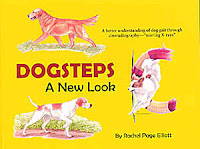From Hoofbeats to Dogsteps: A Life of Listening
to and Learning from Animals, by Rachel Page Elliott
(Dogwise, 2009, 167 pages, $19.95)
The
Grand Dame of American Golden Retrievers
From
Hoofbeats to Dogsteps says it all: a horse loving girl, born in 1913,
grows up to become a canine motion and conformation expert, almost a research scientist,
studying movement and structure in dogs, invited to speak all over the world,
and a woman who took up agility in her 80s.
Almost
a Sculptress
Pagey, Rachel Page Elliott, was a unique and highly respected dog
lady. Although born, raised and a life-long resident of New England, she drove
cross-country at age 18 with her sister Priscilla (Pike*) in a Ford Model A,
and later worked horses on a Montana sheep ranch and at a camp in Utah,
rounding out her college Cliffie (Radcliffe) education as a genuine person, not
a Depression-era debutante from a loving and educated family (reminiscent of Little Women, even down to the towns in
Massachusetts).
Nowhere else will you see Yellowstone as it was in 1930 – or the
Pendleton Roundup.
Perhaps her early interest in soap carving was the impetus for her
decades-long study of golden retriever breeding and anatomy. The Elliotts
established Featherquest
Kennels, still going strong today, specializing in field goldens.
Another hobby Pagey grew into was creating jig-saw puzzles. She
would always include pieces that showed dogs in motion, dogs sitting, dogs and
children, cats, birds, and puppies as well as the myriad usual jig-saw shapes.
And, at the 2009 Golden Retriever National auction for the GR Foundation, one
of Pagey’s puzzles brought in $27,000 and put her in the Guinness book of
records.
They
Bought the Farm (in 1946)
Pagey and her dentist husband bought an old fixer-upper farm in
Massachusetts and lived there all their days – a farm just big enough to hold
canine competitions.
Her studies began with taking photos of moving goldens, then
movies of goldens moving. She managed to spend time at Harvard, using their
resources to research bone and joint motion that was ground-breaking then and routinely
accepted by all, now.
And thus, Dogsteps was born
in 1973! The first edition was to go through eight printings and become a
bestseller. The following year, the book won the Dog Writers’ Association award
and Pagey was awarded the Gaines Dog Woman of the Year.
For
You, If, . . . .
Hoofbeats
is the book to read if you have known Rachel Page Elliott even from a distance
like me, if you want to learn about your parents or grandparents born circa 1913
and growing up in New England or Wyoming or Montana or Oregon during the
Depression, if you are a canine conformation person (dog show) – handler or
breeder, if you are a Golden Retriever lover or have ever been to the National
or even ‘just’ a local dog show or watched Westminster on TV.
On the other hand, Hoofbeats
reads like a folksy old-fashioned letter from grandma rather than a
spellbinding story of yesteryear by an accomplished author. Unlike Karen
London, I loved reading about Pagey’s upbringing and felt the canine gait and
structure chapters were a bit superficial – not detailed enough for this
analytic soul, but I agree with London on the writing style.
The
Biggest Omission
I can’t believe Pagey is not listed in Wikipedia. . . . she should
be, for correcting the fallacy of the 45-degree layback!
Pagey’s Publications
1973 (3rd
edition, 2009, soft cover), Dogsteps: A
new look (and illustrated gait at a glance, 2nd edition, 1983)(New
Dogsteps: A better understanding of dog gait through cineradiography [moving
X-rays], 1st edition, 1973)
2005, Dogsteps DVD: What to look for in a dog
2005, Canine Cineradiography
DVD: A study of bone and joint motion as seen through moving X-rays
2006, The Golden Retriever DVD: - Structure, movement and use
(all available from www.DogWise.com and recommended by the Golden Retriever Club of America [GRCA, www.grca.org])
*Another sister’s delightful
name - Fordham, Fordie.










